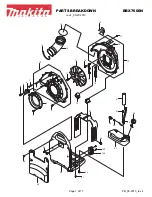
27
Subject to change without notice
readout (2nd line in the top right position), (e.g. dc(Tr):100μV.)
Symbol (Tr) indicates reference to the trigger signal. Someti-
mes a ”?“ will be displayed, indicating that there is no, or an
insuffi cient signal.
If AUTO MEASURE is activated, pressing the AUTO MEASURE
pushbutton again causes the display of the “Measure” menu
and its selection box. Additionally the FOCUS TRACE MENU
pushbutton
3
is lit, indicating that the INTENS knob
2
can
be used to select the measurement mode.
Depending on the operating mode this menu offers various
automatic measurements of the trigger signal. The following
conditions must be met:
a) For frequency or period measurements suffi cient trigger
signals must be available. Use normal triggering for signals
<
20 Hz. Please note that signals of very low frequency may
require seconds to complete one measurement.
b) In order to measure DC or the DC content of a signal the
input channel as well as the trigger must be set to DC coup-
ling.
Further notes:
– Due to the limited frequency response of the trigger channel
the accuracy will decrease with increasing frequency.
– The frequency responses of the vertical channel and the
trigger channel differ substantially; this may affect the signal
display.
– When measuring very low frequency signals the display will
follow the signal.
– When measuring pulse signals there may be an infl uence
of the duty cycle or the slope selected on the accuracy of
the result.
– The signal must remain within the graticule area, i.e. the
input amplifi ers must not be overdriven.
STOP
Please note:
Complex signals should be measured using the
CURSORs.
If a variable is activated and thus the sensitivity or time base
uncalibrated, the ”:“ will be replaced by a ”
>
“ symbol.
14.1 Meas.(uring) Type
If this function is activated, the INTENS knob
2
can be used
for measurement selection. In most cases the corresponding
unit will be automatically displayed. The measuring modes are
self explanatory.
14.2 Respect Tr
The “Respect Tr” display is just a reminder indicating that the
trigger signal is used for measurement. The assigned function
key has no effect.
14.3 Off
Pressing the function key “Off” switches the “AUTO MEASURE”
menu and the measurement result line off.
If only the displayed “AUTO MEASURE” menu is to be switched
off, press the MENU OFF pushbutton
37
.
15
LEVEL A/B
(knob)
The LEVEL control allows to set the trigger level, i.e. the vol-
tage respectively signal level, which will generate a trigger to
start the time base whenever the signal passes that level. In
most Yt- modes the readout will show a symbol the vertical
position of which indicates the signal point which will trigger.
The trigger symbol will not be shown those modes where
there is no direct relationship between trigger signal and
trigger point.
In normal trigger mode the LEVEL control will move the trigger
symbol anywhere. In automatic peak-to-peak detection mode the
level can only be selected between the signal’s peak values.
HM 1
0
0
0-2 - KLB - Stand: 07/1
2/06 gw
HM1
0
0
0 - blau - Stand: 07/1
2/06 gw
HM
10
0
0
-2
- gr
ü
n -
St
an
d
:
07/1
2/06
gw
VAR
VAR
VAR
x10
FOCUS
TRACE
VOLTS / DIV
VAR
VOLTS / DIV
VAR
TIME / DIV
VAR
X-POS
INTENS
!
LEVEL A/B
MENU
AUX
AUXILIARY INPUT
HORIZONTAL
INPUTS
1M
Ω
II15pF
max
400 Vp
CAT I
!
CAT I
!
DELAY
TRACE
SEP
CH 1/2
CURSOR
SAVE/
RECALL
AUTOSET
SETTINGS
HELP
POSITION 1
POSITION 2
VERT/XY
HM1500-2
ANALOG
OSCILLOSCOPE
150 MHz
TRIGGER
MODE
FILTER
SOURCE
TRIG
’
d
NORM
HOLD OFF
AUTO
MEASURE
CURSOR
MEASURE
TRIG. EXT. / Z-INP.
CH 1
CH 2
X-INP
CH 1
CH 2
HOR
MAG
1M
Ω
II
15pF
max
100 Vp
20 V
1 mV
20 V
1 mV
0.5s
50ns
POWER
POWER
MENU
MENU
OFF
OFF
1
2
3
4
5
8
7
6
9
10
11
13
12
14
15
22
23
16
17
24
18
21
25
26
19
20
27
30
28
29
31
32
33
37
C o n t r o l s a n d R e a d o u t









































